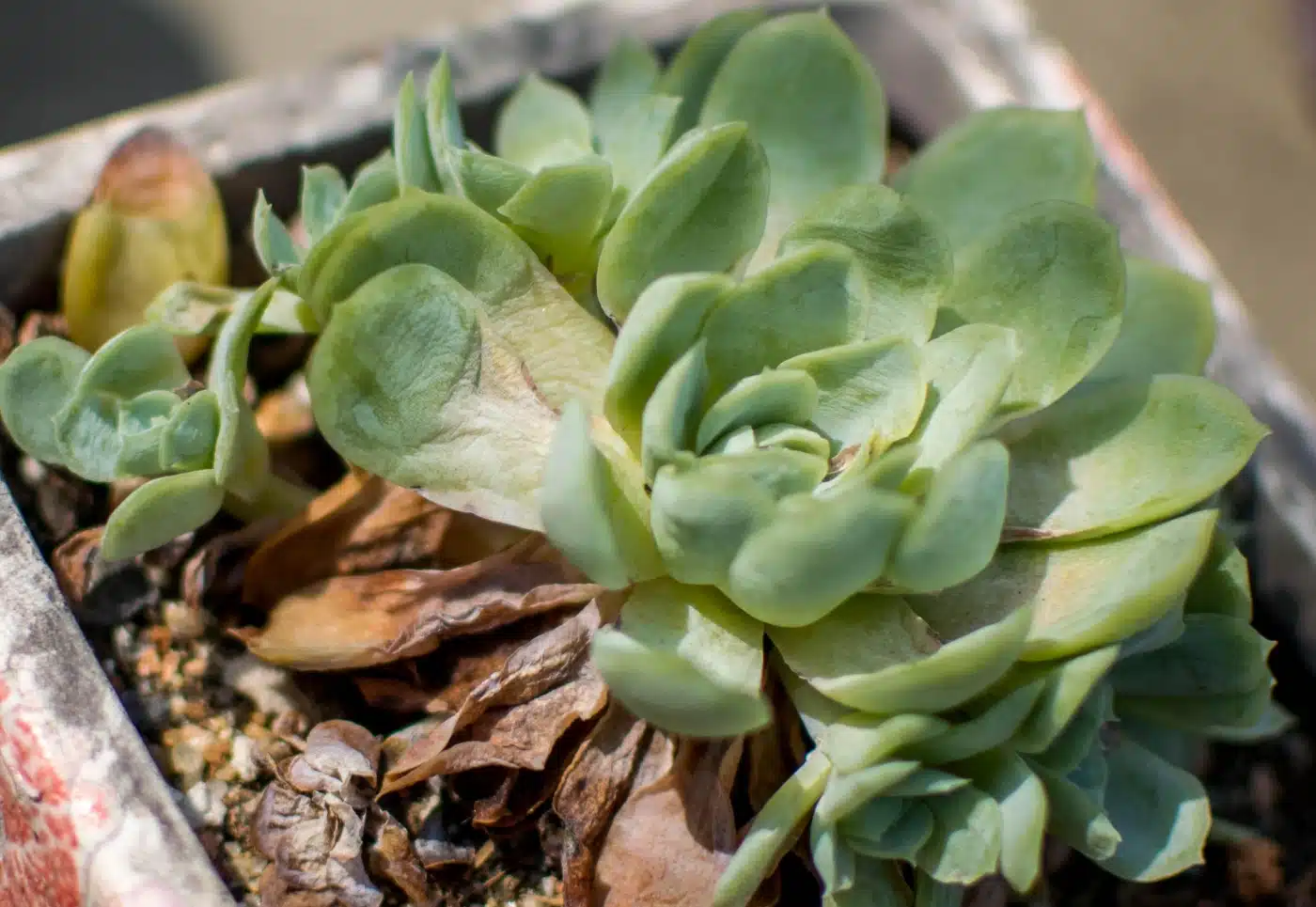Sunlight, while essential for photosynthesis and plant growth, can also be harmful in excess, leading to sunburn. This condition severely affects plant health, impacting leaves and potentially the entire plant, causing growth and health issues.
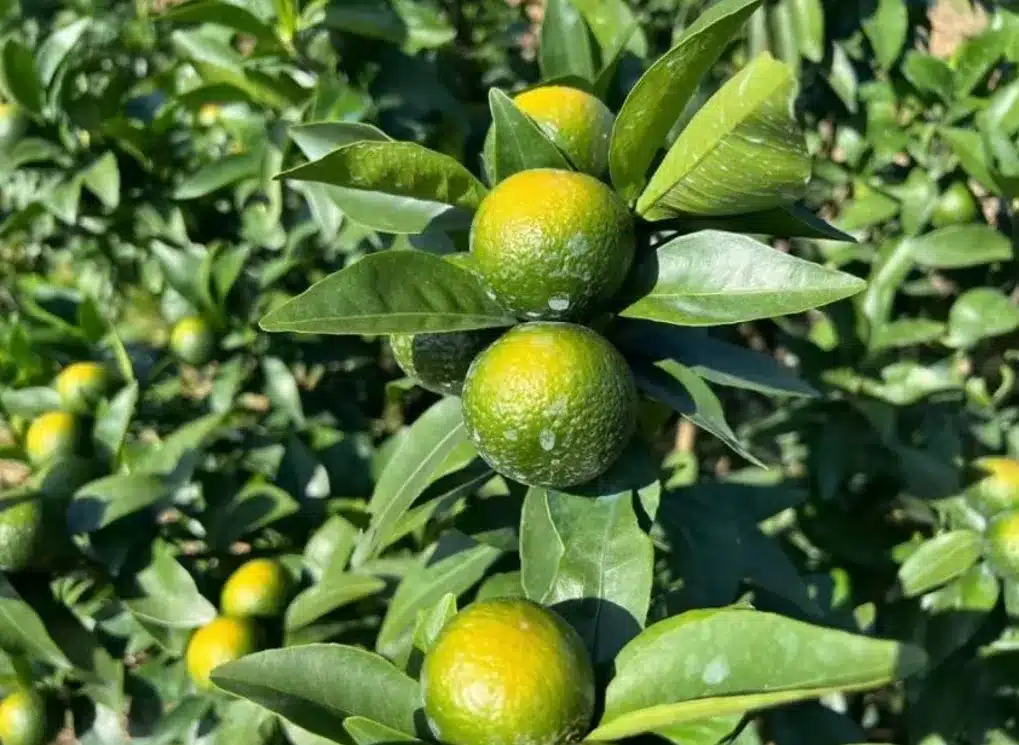
One side of the citrus fruit started to turn yellow due to excessive sunlight
To protect plants from sunburn, understanding and managing its effects are essential for fostering healthy plant growth. Thus, this article offers a complete guide that covers the reasons behind plant sunburn, preventive measures, and how to care for plants that have been sunburned.
Why Do Plants Get Sunburned?
Exposure to too much ultraviolet radiation and heat can damage plant cells, initiating a cascade of negative effects. Sunburned leaves might fade due to cell and oxidative damage from UV rays and heat, hampering photosynthesis and the plant’s growth.

Sun-damaged grapes
Additionally, these leaves may struggle to retain moisture, becoming dry and fragile, disrupting the plant’s hydration balance and hindering its growth and survival. In extreme cases, sunburn leads to wilting leaves and weakened plants, potentially causing death.
Which Plants Are Prone to Sunburn?
Sunlight needs vary across different plants, changing with seasons and growth stages. Some plants, particularly young seedlings and certain flowers like petunias, carnations, and chrysanthemums, as well as trees and fruits such as poplars, pines, oaks, grapes, and apples, are more sunlight-sensitive and prone to sunburn.
Even plants that typically thrive in sunlight, such as tomatoes, may suffer from sunburn during intense summer heat, affecting their appearance and yield. It’s crucial to offer adequate shade and protection to these plants to prevent sunburn. Let’s explore how to safeguard plants from sunburn.
How to Protect Plants from Sunburn?
Protecting plants from sunburn involves a mix of strategies. This piece focuses on selecting the right spot for planting, shading techniques, soil moisture needs, and applying plant sunscreen.
1. Picking the Right Spot
Choosing the right spot to plant is crucial for a plant’s health and growth. The ideal spot offers the right balance of light and water, preventing sunburn and minimizing pests and diseases. This smart choice improves land use and boosts plant quality and yield.
- Understanding Light Needs: Most veggies and fruit trees love sunlight for photosynthesis and should be planted where they get full sun. On the other hand, ferns and some leafy plants like peace lilies prefer shadier spots to avoid sunburn.
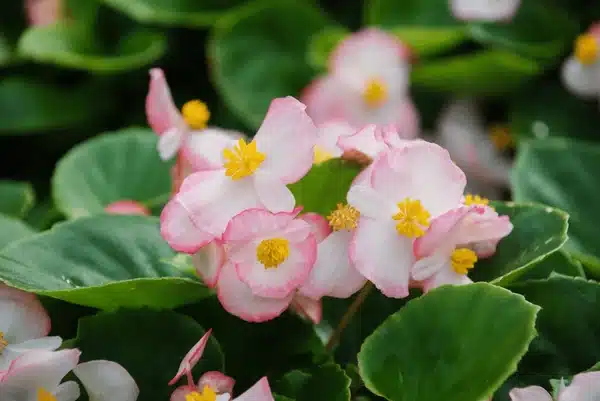
Shade-loving plants – Begonia
- Managing Water: It’s all about planting in areas that match a plant’s love for water. Plants like rice and water lilies need wet areas to thrive and avoid sunburn. Cacti and carnations handle drought well and do best in well-drained sandy soil.
2. Shading Your Plants If Possible
Shading is key for plants that can’t handle direct sunlight, especially during the hot months. The right shade controls temperature and light, helping plants grow healthy. Knowing a plant’s light needs helps you pick the best shading method.
- Shade Nets and Canopies: These are easy and effective ways to block direct sun. Shade nets come in various shading rates, fitting different plant needs. For example, succulents may need 30%-50% shading in summer, while leafy veggies like lettuce might need up to 75% shading to stay calm and light-balanced.
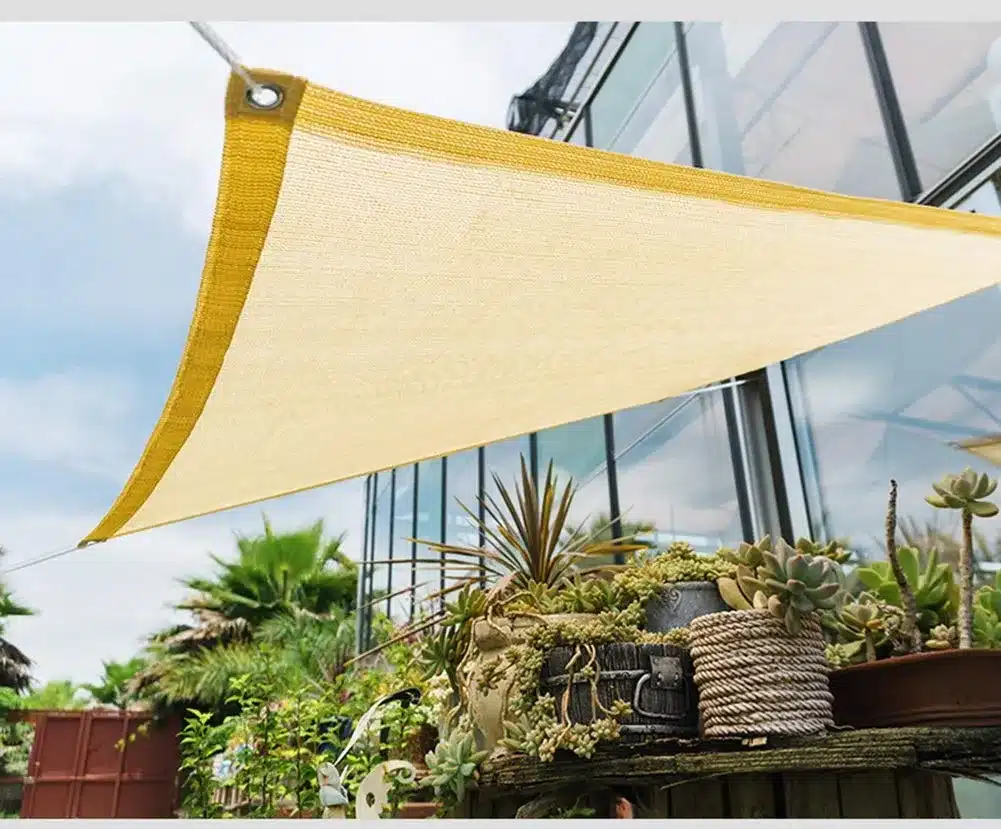
Shade cloth
- Planting Tall Trees: In long-term gardening, planting trees strategically offers natural shade, shielding other plants. For example, tall trees in orchards can protect smaller fruit plants from strong sunlight. This method also boosts biodiversity and aids in pest control.
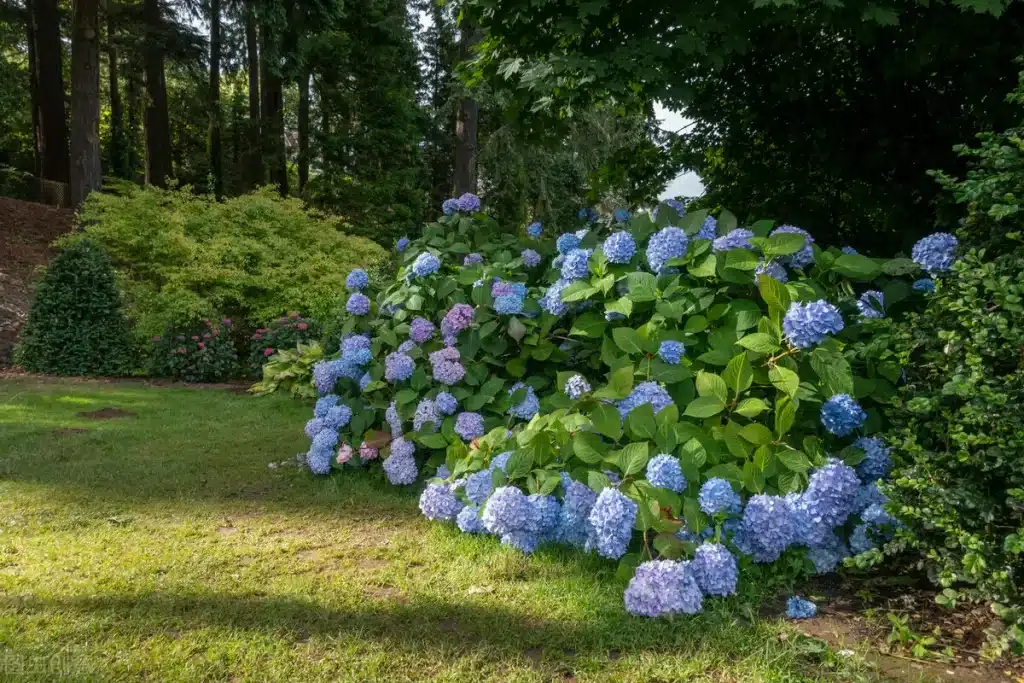
Natural shade
- Other Temporary Shade Structures: For plants needing shade only at certain times, like seasonal flowers or vegetables avoiding the summer heat, temporary solutions like umbrellas or movable frames work well. These flexible options can adapt to changing weather and plant growth stages.
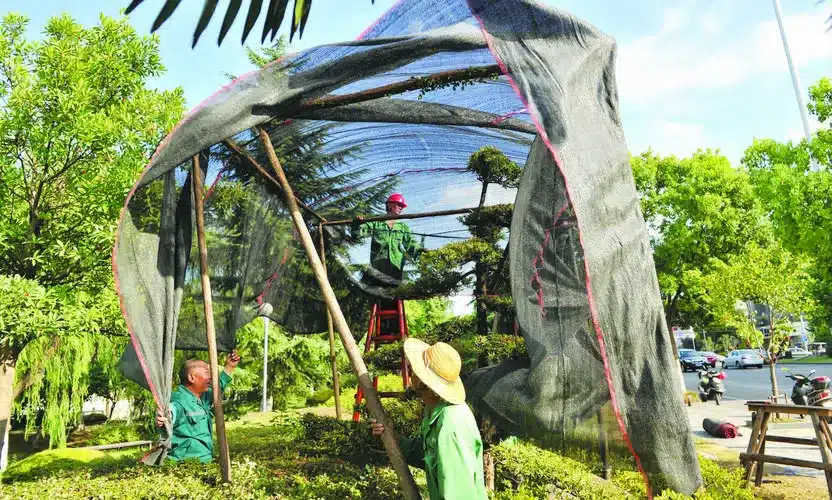
Temporary shade structure
Don’t Miss: How do you choose the right shading rate of cloth for plants?
3. Keep The Soil Moist
Keeping the soil moist is crucial for plants to thrive, especially when it’s hot or dry. The right watering methods can give plants enough water and keep roots healthy. But remember, how you water depends on the plant type.
- Deep Watering for Deep Roots: Fruit trees and big ornamental trees need deep watering. Their roots grow deep and need water from below for deeper moisture. This helps them resist drought better.
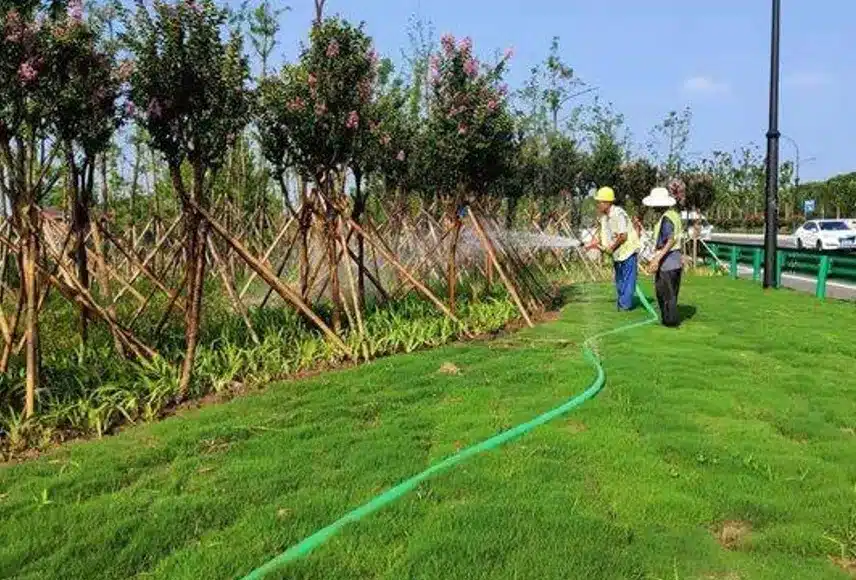
Deep Watering
- Water on a Schedule: Vegetables and lawns in home gardens do well with regular watering. It gives them a constant water supply. It’s best to water early in the morning or late in the evening. This timing helps reduce water loss to evaporation and lets plants soak up water during the day.
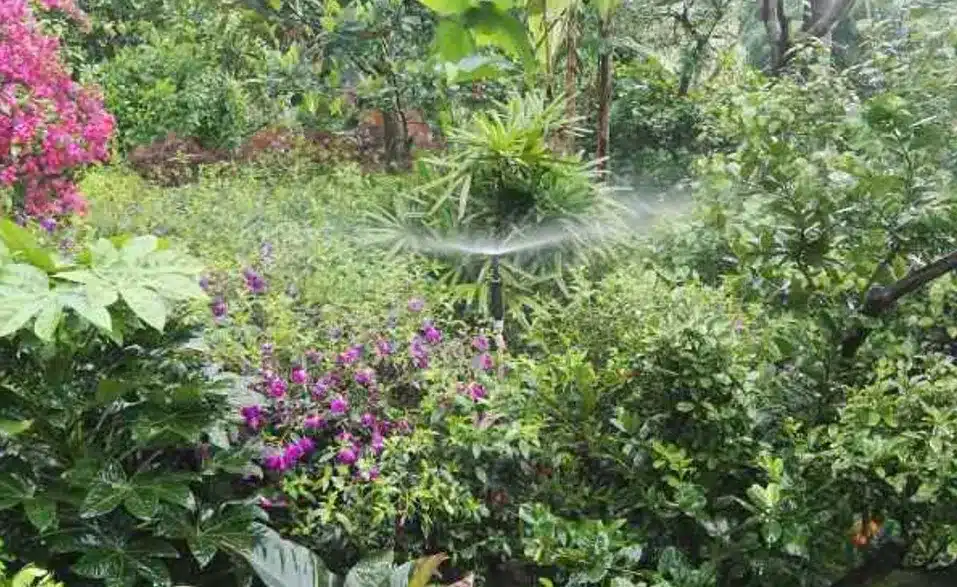
Regular watering
- Drip Irrigation Systems: Many gardens and greenhouses use drip irrigation. This system brings water to the plant roots, cutting down on waste and ensuring the water gets absorbed well.
- Mulching Helps Too: Putting mulch like wood chips or grass clippings on the soil can keep it moist, lower evaporation, and improve soil over time. This works great for plants like roses, violets, and silver buttonwood.
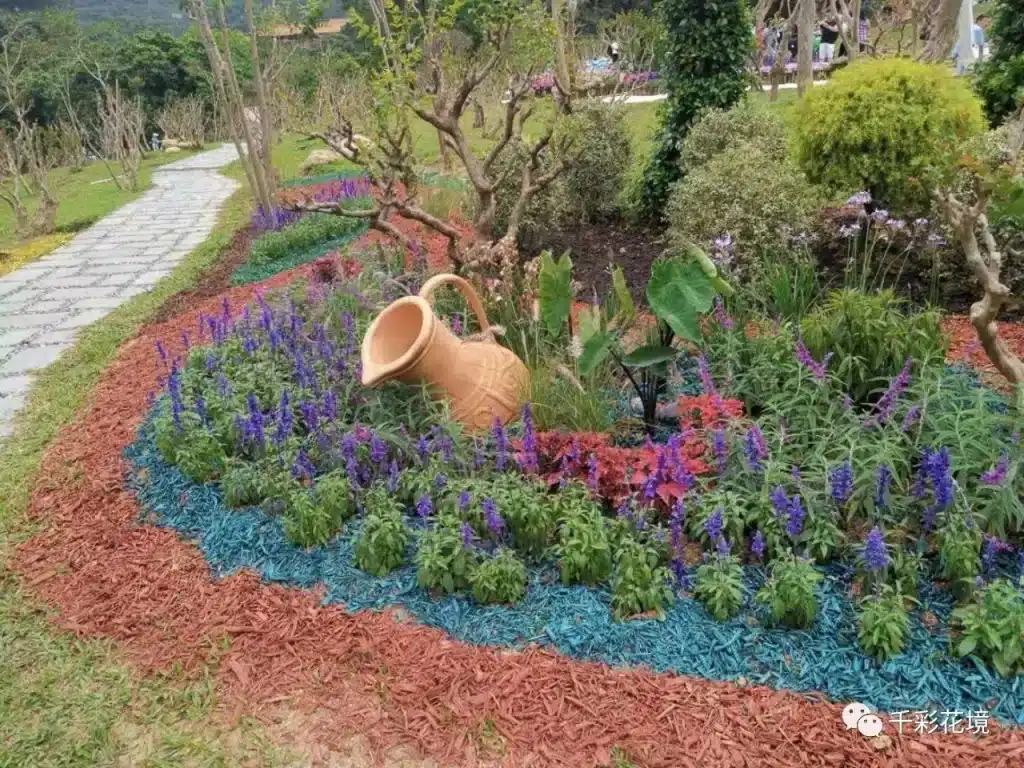
Mulching
- Think About Your Climate: Matching your watering habits to your local climate and soil is key. Cacti, succulents, and herbs like lavender may not need much water in dry places. But plants that love water, like spinach, lettuce, and celery, need regular and plenty to avoid sunburn.
4. Plant Sunscreen
Just like us, plants can use sunscreen. It comes in a spray and forms a protective layer on leaves, blocking some sunlight and protecting from UV rays and heat. There are many sunscreens for plants, both organic and inorganic. Organic ones often have natural ingredients, while inorganic ones may contain reflective minerals.
When using sunscreen, spray after rain and before strong sunlight hits. Make sure to cover all parts, especially those that get direct sun.
5. Painting Tree Trunks
Painting tree trunks with white latex paint can protect young or vulnerable trees from sunburn. This method is good for trees that are directly in the sun. Use interior latex paint, as it’s safer for trees than other types of paint.

Painting Tree Trunks
How to Treat Sunburned Plants
If your plants end up sunburned, it’s crucial to act fast to help them recover.
First, start with recognizing sunburn signs.
Sunburn appears as yellow spots, burnt edges, and either dry or soft leaves, hurting the plant’s health and growth. Spots that are white or yellow on leaves clearly indicate sunburn. If the leaf edges or tips turn dry and yellow, the leaf is losing water. Soft leaves after too much sun suggest cell damage.
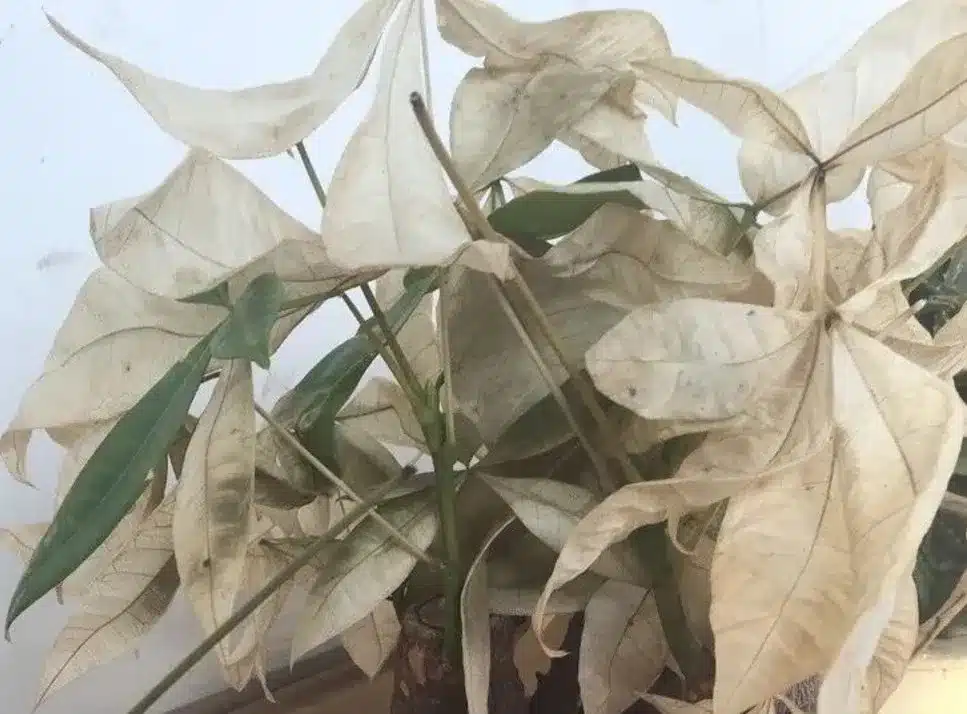
Sunburn appears as yellow spots
Then, go to treat your sunburned plants
To treat sunburned plants, follow these four steps:
- Trim Damaged Leaves: Leaves hurt by the sun won’t fix themselves or grow back. Cutting it off is best if more than half of a leaf is damaged. For lightly to moderately damaged plants, just snip off the bad parts. Always use clean, sterilized tools to avoid spreading diseases.
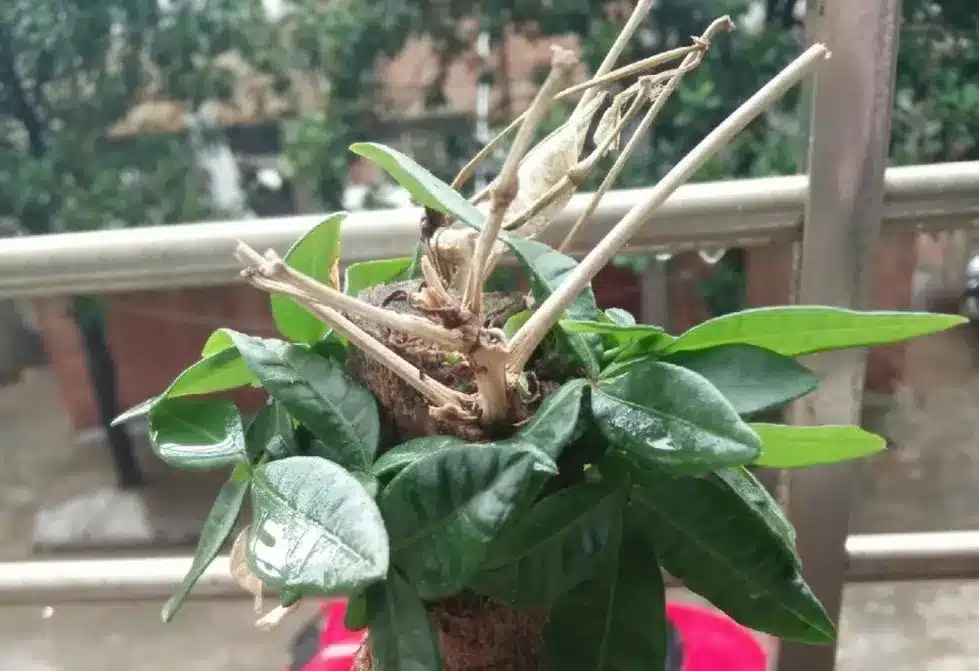
Trim Damaged Leaves
- Keep the Soil Moist: Ensure the soil stays moist, especially during hot weather. Deep watering helps plants drink up water and nutrients to bounce back. But watering too much is also a no-go. Too much water can hurt plants. Use a soil moisture meter to know when to water your plants.
- Add Extra Shade: Protect sunburned plants from more sunlight with shade nets, canopies, or portable umbrellas. This extra shade helps plants adjust and start growing again slowly.
- Fertilize Wisely: Once your plants begin to recover, gently fertilize them with a low-strength liquid fertilizer to encourage new leaves. Avoid fertilizing plants that are badly damaged or when the soil is dry. This could stress the plants and slow down their recovery.
Keep checking on your plants regularly after taking these steps to ensure they don’t show new signs of sunburn. Adjust the shade you give them based on how well they recover and the weather. You can slowly let them get more light as they get used to it, which helps them grow strong and healthy.
Conclusion
By taking these combined steps, you can significantly protect plants from sunburn and encourage their growth. This involves understanding plant habits and continuously watching and tweaking your care approach based on your location’s conditions. I hope these methods offer helpful guidance for your gardening sun protection efforts.
